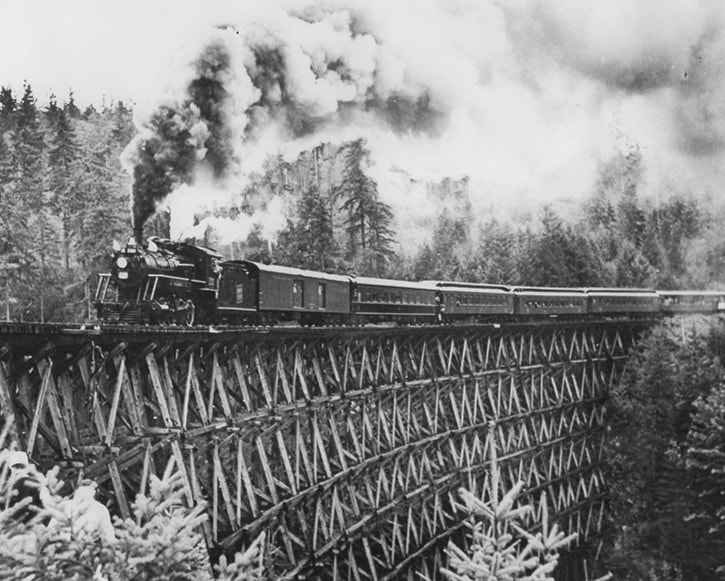Folks who have lived long in the community recall the steam locomotives that hauled the Canadian National Railway cars from the Sooke Hills down to Selkirk Inlet in Victoria or on the spur out to offload at Cowichan Bay.
When the railway survey started out though, in 1910, it was undertaken by the Canadian Northern Pacific Railway, whose plans for Vancouver Island included proposed routes to Campbell River, Port Hardy and along the coast to Port Alberni.
In 1911, the printing firm of T. N. Hibben & Co. of Victoria published a document from which we excerpt here. We may marvel at the differences, and at the similarities, of such a document if it were published today. “The greatest wealth of merchantable timber in proportion to acreage in the known world.” “The most extensive deposits of coal, and that of the best quality on the Pacific Coast.” “The most extensive unprospected copper and other mineralized areas of British Columbia.” “The only extensive deposits of iron on the Pacific Coast.”
“The congregated essentials of a great shipbuilding industry.” “The most favourable area for mixed farming and dairying.” The most abundant water power.” “The best cement deposits.” “The most liberal and progressive education system.” “The most important whale fisheries in the world.” “The social and political capital.” (We are indebted for information to Robert M. Danielson of Calgary who researched a history of the Canadian Northern Pacific Railway in memory of his father, a railway surveyor.)
It was in this milieu then, and with Dunsmuir’s Esquimalt & Nanaimo Railway already in operation, that the CNPR began its ambitious plans to facilitate the industrial development of Vancouver Island. Records of construction camps situated near Sooke show names of Italian, British and Scandinavian origin, where the men worked 11-hour days for a wage of $2.50 per day.
Hundreds of men were employed in heavy rock work and blasting as the grade was cleared following the east bank of the upper Sooke River. Once the ties were placed and the rail laid, logging operations in the uplands of the Sooke Hills and the Cowichan Valley soon took advantage of the freight line to transport their logs, poles and their milled lumber to markets.
By 1918 the railway, much reduced from its initial scope, had been taken over by the Canadian government and became part of the Canadian National Railway. The farthest north destination for the train was Youbou and Kissinger, plus a spur to Cowichan Bay. Daily, pioneer residents would hear the sharp hoot of a warning alert, or the long drawn out wail of the steam whistle as the locomotive chugged through the hills.
Besides the freight trains, there was a period from 1922 to 1931 when a gas car carried passengers on the line – two different gas-powered models were run during that period. These self-contained units had no locomotive and no caboose, and relatively comfortable seating for passengers who might travel from Victoria to Leechtown.
Note: After this railway route had its rails lifted and became a CRD park called the Galloping Goose Regional Trail Park in 1989, the term was a bit of a misnomer, as our CNR gas car in the 1920s had never been called by that name. Perhaps it’s no matter, it’s kind of a cute name, though the term came from a line in the B.C. Interior. Nowadays the popular and much-used trail is generally just called “The Goose” anyway.
One of Vancouver Island’s treasured citizens was a man called Gerry Wellburn, who started the B.C. Forest Museum in Duncan. He was in the forest industry and his love of local history was such that he collected and preserved logging and railway artifacts from throughout the south island. At the Sooke Region Museum we got to know him well, as he shared treasures with us.
We even found a Sooke-Cowichan connection, as Gerry Wellburn’s daughter Lois married Jack Phillips, a cousin of the Phillips family for whom Sooke’s Phillips Road is named. Lois Phillips, a Koksilah resident, has kindly shared with us some of her dad’s photos and documents.
When the National Model Railroad Association met in Victoria in 1954, Gerry Wellburn was so well-connected to CNR officialdom that the president organized barges to transport Pullman cars from Vancouver’s station to Pt. Ellice Bridge where they were offloaded and hooked up to a steam locomotive on our CNR line.
What an exciting event, as dozens of railroad aficionados and their families boarded the excursion which went as far as Deerholme, where there was a Wye Turnaround so the train could make the reverse journey.
By the 1960s the era of steam was over, the line was now powered by diesel locomotives and in its last years was engaged in transporting cargo of munitions from Cowichan Bay to Rocky Point. Files of CNR records in 1971 show the status of the line then: Stations were Colwood, Metchosin, Rocky Point, Saseenos, Milne’s Landing, Leechtown, Lakend, Deerholme; Spurs (sidings) were – Ballast Pit, Antrobus, R. C. Hughes, Victoria Plywood.
By 1979 the Canadian Transport Commission had authorized abandonment of the entire line. A changing world and changing industries are to be expected, but at the same time, many of us share a nostalgic thought for the mournful wail of the steam whistle echoing through the hills.
•••
Elida Peers is the historian of the Sooke Region Museum.
